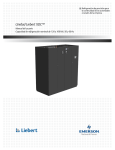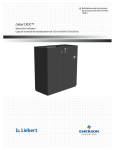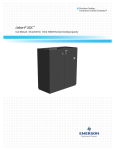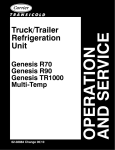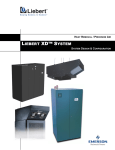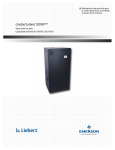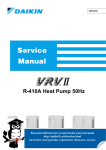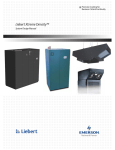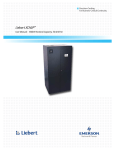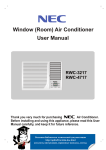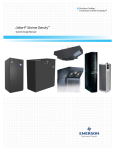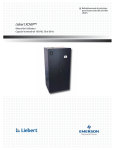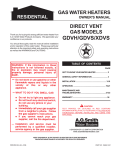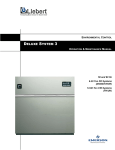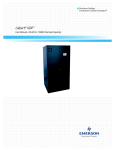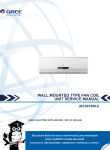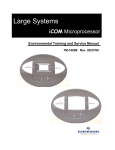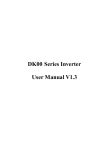Download Liebert XDC™
Transcript
Precision Cooling for Business Critical Continuity Liebert XDC™ User Manual 50 and 60 Hz, 130 & 160kW Nominal Cooling Capacity http://splitoff.ru/tehn-doc.html , , , . GENERAL SAFETY GUIDELINES ! WARNING ! WARNING Risk of electric shock. Can cause injury or death. Disconnect local and remote power supplies before working within. Before proceeding with installation of XDC, read all instructions, verify that all the parts are included, and check the nameplate to be sure the XDC voltage matches available utility power. Follow all local codes. Risk of unit falling over. Can cause injury or death.The XDC is top-heavy. Use extreme caution and care when moving and installing this unit. NOTE This document shall be used together with site specific documentation and documentation for other parts of the system (heat rejection devices and cooling modules). NOTE Before any action that could cause a disturbance in the XD system’s cooling function is begun, the facility manager MUST be informed. In addition, after the action is taken and the work is finished, the facility manager MUST be informed. ! Figure i CAUTION Risk of piping and component rupture. May cause injury or equipment damage. Closing service valves may isolate liquid refrigerant, causing high pressure and rupture of piping. Do not close valves without follow recommended procedures for repair, maintenance and replacement of components. Installing pressure relief valves in field piping that may become isolated by service valves. Model number nomenclature Example: XDC160AA– –0 XD C Chiller unit Liebert X-treme heat Density system 160 A A A = Air W = Water G = Glycol (heat rejection method) 160kW nominal capacity – – Place holder A = 460V-3ph-60Hz (voltage-phase-frequency) M = 380/420-3ph-50Hz 0 Revision level Place holder : http://splitoff.ru/tehn-doc.html TABLE OF CONTENTS GENERAL SAFETY GUIDELINES . . . . . . . . . . . . . . . . . . . . . . . . . . . . . . . . . . . INSIDE FRONT COVER 1.0 PRODUCT DESCRIPTION . . . . . . . . . . . . . . . . . . . . . . . . . . . . . . . . . . . . . . . . . . . . . . . . . . .1 1.1 General Product Information. . . . . . . . . . . . . . . . . . . . . . . . . . . . . . . . . . . . . . . . . . . . . . . . . . . 1 1.1.1 Product/System Description. . . . . . . . . . . . . . . . . . . . . . . . . . . . . . . . . . . . . . . . . . . . . . . . . . . . . 1 1.2 Equipment Inspection . . . . . . . . . . . . . . . . . . . . . . . . . . . . . . . . . . . . . . . . . . . . . . . . . . . . . . . . 1 1.3 Equipment Handling . . . . . . . . . . . . . . . . . . . . . . . . . . . . . . . . . . . . . . . . . . . . . . . . . . . . . . . . . 1 1.3.1 1.3.2 1.3.3 1.4 Mechanical Considerations . . . . . . . . . . . . . . . . . . . . . . . . . . . . . . . . . . . . . . . . . . . . . . . . . . . . 4 1.4.1 1.5 Handling With Skid . . . . . . . . . . . . . . . . . . . . . . . . . . . . . . . . . . . . . . . . . . . . . . . . . . . . . . . . . . . 2 Removal of Skid . . . . . . . . . . . . . . . . . . . . . . . . . . . . . . . . . . . . . . . . . . . . . . . . . . . . . . . . . . . . . . 2 Removing Piano Jacks . . . . . . . . . . . . . . . . . . . . . . . . . . . . . . . . . . . . . . . . . . . . . . . . . . . . . . . . . 4 Positioning the XDC . . . . . . . . . . . . . . . . . . . . . . . . . . . . . . . . . . . . . . . . . . . . . . . . . . . . . . . . . . . 4 High Voltage Connections . . . . . . . . . . . . . . . . . . . . . . . . . . . . . . . . . . . . . . . . . . . . . . . . . . . . . 6 1.5.1 Connecting High-Voltage Cables . . . . . . . . . . . . . . . . . . . . . . . . . . . . . . . . . . . . . . . . . . . . . . . . . 6 1.6 Extra Low Voltage Connections . . . . . . . . . . . . . . . . . . . . . . . . . . . . . . . . . . . . . . . . . . . . . . . . 9 2.0 PIPING . . . . . . . . . . . . . . . . . . . . . . . . . . . . . . . . . . . . . . . . . . . . . . . . . . . . . . . . . . . . . . .12 2.1 Recommended Pipe Size. . . . . . . . . . . . . . . . . . . . . . . . . . . . . . . . . . . . . . . . . . . . . . . . . . . . . . 12 2.2 XDC Interconnection With XDO or XDV . . . . . . . . . . . . . . . . . . . . . . . . . . . . . . . . . . . . . . . . 12 2.3 Piping Installation Method . . . . . . . . . . . . . . . . . . . . . . . . . . . . . . . . . . . . . . . . . . . . . . . . . . . 14 2.3.1 2.3.2 2.3.3 Piping Installation—R-134a Pumped Circuit . . . . . . . . . . . . . . . . . . . . . . . . . . . . . . . . . . . . . . 14 Direct Expansion (DX) Circuit—R-407c Air Cooled Units . . . . . . . . . . . . . . . . . . . . . . . . . . . . 14 Air Cooled Condenser with Lee-Temp “Flooded Condenser” Head Pressure Control System— R-407c (DX) Circuit17 3.0 FILLING THE XDC’S CIRCUITS WITH COOLANT . . . . . . . . . . . . . . . . . . . . . . . . . . . . . . . . . 18 3.1 Filling the Pumped Circuit (R-134A) . . . . . . . . . . . . . . . . . . . . . . . . . . . . . . . . . . . . . . . . . . . 18 3.2 Filling the Direct Expansion (DX) Circuit - R-407C. . . . . . . . . . . . . . . . . . . . . . . . . . . . . . . . 19 3.3 Checklist for Proper Installation . . . . . . . . . . . . . . . . . . . . . . . . . . . . . . . . . . . . . . . . . . . . . . . 19 4.0 CHECKLIST FOR XDC STARTUP . . . . . . . . . . . . . . . . . . . . . . . . . . . . . . . . . . . . . . . . . . . . 20 5.0 MICROPROCESSOR CONTROL . . . . . . . . . . . . . . . . . . . . . . . . . . . . . . . . . . . . . . . . . . . . . . 22 5.1 Feature Overview . . . . . . . . . . . . . . . . . . . . . . . . . . . . . . . . . . . . . . . . . . . . . . . . . . . . . . . . . . . 22 5.1.1 5.2 Controls . . . . . . . . . . . . . . . . . . . . . . . . . . . . . . . . . . . . . . . . . . . . . . . . . . . . . . . . . . . . . . . . . . . 23 5.2.1 5.2.2 5.3 Display . . . . . . . . . . . . . . . . . . . . . . . . . . . . . . . . . . . . . . . . . . . . . . . . . . . . . . . . . . . . . . . . . . . . 22 Feature Overview . . . . . . . . . . . . . . . . . . . . . . . . . . . . . . . . . . . . . . . . . . . . . . . . . . . . . . . . . . . . 23 Status Display . . . . . . . . . . . . . . . . . . . . . . . . . . . . . . . . . . . . . . . . . . . . . . . . . . . . . . . . . . . . . . 23 Main Menu . . . . . . . . . . . . . . . . . . . . . . . . . . . . . . . . . . . . . . . . . . . . . . . . . . . . . . . . . . . . . . . . 23 5.3.1 5.3.2 5.3.3 5.3.4 5.3.5 Viewing or Changing Settings . . . . . . . . . . . . . . . . . . . . . . . . . . . . . . . . . . . . . . . . . . . . . . . . . . SETPOINTS . . . . . . . . . . . . . . . . . . . . . . . . . . . . . . . . . . . . . . . . . . . . . . . . . . . . . . . . . . . . . . . . STATUS . . . . . . . . . . . . . . . . . . . . . . . . . . . . . . . . . . . . . . . . . . . . . . . . . . . . . . . . . . . . . . . . . . . ACTIVE ALARMS . . . . . . . . . . . . . . . . . . . . . . . . . . . . . . . . . . . . . . . . . . . . . . . . . . . . . . . . . . . ALARM HISTORY . . . . . . . . . . . . . . . . . . . . . . . . . . . . . . . . . . . . . . . . . . . . . . . . . . . . . . . . . . . i : http://splitoff.ru/tehn-doc.html 23 24 24 25 25 5.3.6 5.3.7 5.3.8 5.3.9 5.3.10 5.3.11 5.3.12 5.3.13 5.3.14 5.3.15 5.3.16 5.3.17 TIME . . . . . . . . . . . . . . . . . . . . . . . . . . . . . . . . . . . . . . . . . . . . . . . . . . . . . . . . . . . . . . . . . . . . . . DATE. . . . . . . . . . . . . . . . . . . . . . . . . . . . . . . . . . . . . . . . . . . . . . . . . . . . . . . . . . . . . . . . . . . . . . SETUP OPERATION . . . . . . . . . . . . . . . . . . . . . . . . . . . . . . . . . . . . . . . . . . . . . . . . . . . . . . . . . SETPT PASSWORD . . . . . . . . . . . . . . . . . . . . . . . . . . . . . . . . . . . . . . . . . . . . . . . . . . . . . . . . . . SETUP PASSWORD . . . . . . . . . . . . . . . . . . . . . . . . . . . . . . . . . . . . . . . . . . . . . . . . . . . . . . . . . CALIBRATE SENSORS. . . . . . . . . . . . . . . . . . . . . . . . . . . . . . . . . . . . . . . . . . . . . . . . . . . . . . . ALARM ENABLE. . . . . . . . . . . . . . . . . . . . . . . . . . . . . . . . . . . . . . . . . . . . . . . . . . . . . . . . . . . . ALARM TIME DELAY. . . . . . . . . . . . . . . . . . . . . . . . . . . . . . . . . . . . . . . . . . . . . . . . . . . . . . . . COM ALARM ENABLE . . . . . . . . . . . . . . . . . . . . . . . . . . . . . . . . . . . . . . . . . . . . . . . . . . . . . . . CUSTOM ALARMS . . . . . . . . . . . . . . . . . . . . . . . . . . . . . . . . . . . . . . . . . . . . . . . . . . . . . . . . . . CUSTOM TEXT . . . . . . . . . . . . . . . . . . . . . . . . . . . . . . . . . . . . . . . . . . . . . . . . . . . . . . . . . . . . . DIAGNOSTICS. . . . . . . . . . . . . . . . . . . . . . . . . . . . . . . . . . . . . . . . . . . . . . . . . . . . . . . . . . . . . . 25 25 26 28 28 28 29 29 30 30 30 31 6.0 ALARM DESCRIPTIONS AND SOLUTIONS . . . . . . . . . . . . . . . . . . . . . . . . . . . . . . . . . . . . . .32 6.1 Alarm Descriptions. . . . . . . . . . . . . . . . . . . . . . . . . . . . . . . . . . . . . . . . . . . . . . . . . . . . . . . . . . 32 6.2 Red and Green Lamp Indicators . . . . . . . . . . . . . . . . . . . . . . . . . . . . . . . . . . . . . . . . . . . . . . . 33 6.3 Enable / Disable Alarms. . . . . . . . . . . . . . . . . . . . . . . . . . . . . . . . . . . . . . . . . . . . . . . . . . . . . . 34 6.4 Alarm Time Delays. . . . . . . . . . . . . . . . . . . . . . . . . . . . . . . . . . . . . . . . . . . . . . . . . . . . . . . . . . 34 6.5 View Active Alarms . . . . . . . . . . . . . . . . . . . . . . . . . . . . . . . . . . . . . . . . . . . . . . . . . . . . . . . . . 34 6.6 View Alarm History . . . . . . . . . . . . . . . . . . . . . . . . . . . . . . . . . . . . . . . . . . . . . . . . . . . . . . . . . 35 6.7 System Shutdown Causes . . . . . . . . . . . . . . . . . . . . . . . . . . . . . . . . . . . . . . . . . . . . . . . . . . . . 35 7.0 TROUBLESHOOTING . . . . . . . . . . . . . . . . . . . . . . . . . . . . . . . . . . . . . . . . . . . . . . . . . . . . . 36 8.0 MAINTENANCE . . . . . . . . . . . . . . . . . . . . . . . . . . . . . . . . . . . . . . . . . . . . . . . . . . . . . . . . . 38 8.1 Air Cooled Condenser. . . . . . . . . . . . . . . . . . . . . . . . . . . . . . . . . . . . . . . . . . . . . . . . . . . . . . . . 38 9.0 SPECIFICATIONS . . . . . . . . . . . . . . . . . . . . . . . . . . . . . . . . . . . . . . . . . . . . . . . . . . . . . . . .39 ii : http://splitoff.ru/tehn-doc.html FIGURES Figure 1 Figure 2 Figure 3 Figure 4 Figure 5 Figure 6 Figure 7 Figure 8 Figure 9 Figure 10 Figure 11 Figure 12 Figure 13 Figure 14 Figure 15 Figure 16 Figure 17 Figure 18 Figure 19 Figure 20 Figure 21 Figure 22 XDC components . . . . . . . . . . . . . . . . . . . . . . . . . . . . . . . . . . . . . . . . . . . . . . . . . . . . . . . . . . . . . . . . . 1 Moving XDC with forklift . . . . . . . . . . . . . . . . . . . . . . . . . . . . . . . . . . . . . . . . . . . . . . . . . . . . . . . . . . 2 Remove tie-down brackets . . . . . . . . . . . . . . . . . . . . . . . . . . . . . . . . . . . . . . . . . . . . . . . . . . . . . . . . . 3 Remove pallet, insert piano jacks. . . . . . . . . . . . . . . . . . . . . . . . . . . . . . . . . . . . . . . . . . . . . . . . . . . . 3 Dimensional data . . . . . . . . . . . . . . . . . . . . . . . . . . . . . . . . . . . . . . . . . . . . . . . . . . . . . . . . . . . . . . . . 5 Piping locations . . . . . . . . . . . . . . . . . . . . . . . . . . . . . . . . . . . . . . . . . . . . . . . . . . . . . . . . . . . . . . . . . . 5 Front view of XDC and electrical enclosures. . . . . . . . . . . . . . . . . . . . . . . . . . . . . . . . . . . . . . . . . . . 6 Electrical enclosure knockout locations for field wiring . . . . . . . . . . . . . . . . . . . . . . . . . . . . . . . . . . 7 60Hz models, high voltage connections—primary disconnect switch . . . . . . . . . . . . . . . . . . . . . . . 7 50Hz models high voltage connections—primary disconnect switch . . . . . . . . . . . . . . . . . . . . . . . . 8 60Hz models high voltage connections—secondary disconnect switch . . . . . . . . . . . . . . . . . . . . . . 8 50Hz models high voltage connections—secondary disconnect switch . . . . . . . . . . . . . . . . . . . . . . 9 XDC heat rejection connection points . . . . . . . . . . . . . . . . . . . . . . . . . . . . . . . . . . . . . . . . . . . . . . . . 9 Electrical enclosure knockout locations for ELV. . . . . . . . . . . . . . . . . . . . . . . . . . . . . . . . . . . . . . . 10 XDC ELV field connections points . . . . . . . . . . . . . . . . . . . . . . . . . . . . . . . . . . . . . . . . . . . . . . . . . . 11 XDC system diagram . . . . . . . . . . . . . . . . . . . . . . . . . . . . . . . . . . . . . . . . . . . . . . . . . . . . . . . . . . . . 12 Branch piping to XDO/XDV . . . . . . . . . . . . . . . . . . . . . . . . . . . . . . . . . . . . . . . . . . . . . . . . . . . . . . . 13 Installation data—Lee-Temp, one-circuit, four- or six-fan model . . . . . . . . . . . . . . . . . . . . . . . . . 15 General arrangement air cooled XDChiller Lee-Temp Control . . . . . . . . . . . . . . . . . . . . . . . . . . . 16 System R-134a liquid level . . . . . . . . . . . . . . . . . . . . . . . . . . . . . . . . . . . . . . . . . . . . . . . . . . . . . . . . 21 User interface . . . . . . . . . . . . . . . . . . . . . . . . . . . . . . . . . . . . . . . . . . . . . . . . . . . . . . . . . . . . . . . . . . 22 Outdoor fan/condenser configuration. . . . . . . . . . . . . . . . . . . . . . . . . . . . . . . . . . . . . . . . . . . . . . . . 38 TABLES Table 1 Table 2 Table 3 Table 4 Table 5 Table 6 Table 7 Table 8 Table 9 Table 10 Table 11 Table 12 Table 13 Table 14 Supply, return pipe sizes for XD Coolant loop . . . . . . . . . . . . . . . . . . . . . . . . . . . . . . . . . . . . . . . . Recommended refrigerant line sizes, DX R-407c, OD copper. . . . . . . . . . . . . . . . . . . . . . . . . . . . . Coolant volume calculations – XDC with XDV systems . . . . . . . . . . . . . . . . . . . . . . . . . . . . . . . . . Coolant volume calculation – XDC with XDO16 systems. . . . . . . . . . . . . . . . . . . . . . . . . . . . . . . . XDC pump light indicator (use the rotation tester for 460V models) . . . . . . . . . . . . . . . . . . . . . . Indoor unit refrigerant charge—R-407C . . . . . . . . . . . . . . . . . . . . . . . . . . . . . . . . . . . . . . . . . . . . . Outdoor condenser charge—R-407C . . . . . . . . . . . . . . . . . . . . . . . . . . . . . . . . . . . . . . . . . . . . . . . . Liquid line charge - R-407C refrigerant per 100 ft (30 m) of Type "L" copper tube . . . . . . . . . . . Bypass flow controllers . . . . . . . . . . . . . . . . . . . . . . . . . . . . . . . . . . . . . . . . . . . . . . . . . . . . . . . . . . . User interface keypad functions. . . . . . . . . . . . . . . . . . . . . . . . . . . . . . . . . . . . . . . . . . . . . . . . . . . . Setpoint functions, default values and allowable ranges . . . . . . . . . . . . . . . . . . . . . . . . . . . . . . . . Setup operation functions default values and allowable ranges. . . . . . . . . . . . . . . . . . . . . . . . . . . XDC DIP switches and factory settings. . . . . . . . . . . . . . . . . . . . . . . . . . . . . . . . . . . . . . . . . . . . . . Liebert XDC specifications . . . . . . . . . . . . . . . . . . . . . . . . . . . . . . . . . . . . . . . . . . . . . . . . . . . . . . . . iii : http://splitoff.ru/tehn-doc.html 12 16 18 18 18 19 19 19 20 22 24 26 27 39 iv : http://splitoff.ru/tehn-doc.html Product Description 1.0 PRODUCT DESCRIPTION 1.1 General Product Information 1.1.1 Product/System Description The XDC (eXtreme Density Chiller) is self-contained refrigeration distribution unit designed to cool rooms with high heat producing equipment. There are two distinct circuits, each utilizing different refrigerants and mechanical parts. The R-134a circuit is the “pumped” circuit containing redundant circulating pumps, a brazed plate heat exchanger along with valves and piping. The R-407c circuit is the dual direct expansion circuit containing scroll compressors, expansion valves, brazed plate heat exchanger, and piping. Heat removal is accomplished by using condensers connected to the dual direct expansion circuit. See Figure 1 below. The XDC monitors room conditions and prevents coil condensation by maintaining the coolant being pumped to the cooling modules at a temperature above the room dew point. All functions, such as temperature control, switching pumps (if necessary), etc., are automatic. The XDC160 is rated for 160kW (546,000 BTU/H) of cooling (nominal rating). Figure 1 XDC components XDC Unit Condenser Unit Compressor Heat Exchanger 1.2 XDO/XDV Fan Coils (XDO shown) Pumps Receiver Equipment Inspection When the unit is delivered, inspect all items for visible and concealed damage. Damage should be immediately reported to the carrier and a damage claim filed with a copy sent to Liebert or to your sales representative. 1.3 Equipment Handling ! WARNING Risk of unit falling over. Can cause injury or death.The XDC is top-heavy. Use extreme caution and care when moving and installing this unit. 1 : http://splitoff.ru/tehn-doc.html Product Description 1.3.1 Handling With Skid • Always keep the unit upright, indoors and protected from damage. • If possible transport the unit using a forklift truck; otherwise use a crane with belts or cables. When using a crane, apply spreader bars to avoiding pressing on the top edges of the packaging. • Personnel should be properly certified and trained to move and rig equipment. • If using a forklift truck, make sure that the forks (if adjustable) are spread to the widest allowable distance that will fit under the skid. • When moving the skidded unit with a forklift truck, do not lift the unit any higher than 6" (152mm) off the ground. If circumstances require the unit to be lifted higher than 6" (152mm), great care must be exercised, and all personnel not directly involved in raising the unit must be no closer than 20 feet (5m) from the lift point of the unit. ! 1.3.2 CAUTION Risk of equipment or building damage. While on the skid, the unit is too tall (83" [2108mm] overall height) to fit through a standard doorway 83" [2108mm]. Any attempt to move the unit, while skidded, through a standard doorway will cause damage to the unit and to the building. Removal of Skid For skid removal, Liebert Corporation recommends using pallet jack or similar operation. This is to ensure that both ends of the unit are firmly secure, and provides a good means of unit mobility. Always keep the unit upright, indoors and protected from damage. 1. Remove the exterior packaging. 2. Align forklift with either the front or rear of the unit. Ensure the forks are locked at the widest position that will fit under pallet (see Figure 2). Figure 2 Moving XDC with forklift Spread forks as far apart as possible and drive forklift against the XDC ! CAUTION Risk of unit damage. Ensure the forklift tines are level and not angled in an upward direction. Improper positioning may cause damage to the bottom of the unit. Ensure the forks are positioned in a manner as to have the Center of Gravity label, located on the unit, centered between the tines. Ensure the tines extend beyond the opposite side of the unit. 3. Drive the forklift forward, sliding the forks under the base of the unit (see Figure 2). 2 : http://splitoff.ru/tehn-doc.html Product Description 4. Move the XDC to its installation location. ! WARNING Risk of unit falling over. May cause injury, death or equipment damage. Move, lift and lower the XDC slowly. To reduce the chance of tipping, keep the XDC as low as practical. 5. Remove all lag bolts from the four (4) corner tie-down brackets. Remove the tie-down brackets from the unit. (see Figure 3). Figure 3 Remove tie-down brackets Unscrew lag bolts and remove brackets to release the XDC from the pallet. There are four brackets, one bracket on each corner. 6. Lift the XDC about an inch and remove the shipping pallet. Figure 4 Remove pallet, insert piano jacks 3 : http://splitoff.ru/tehn-doc.html Product Description 7. Place piano jacks at either end of the XDC and lower it until it is supported by the piano jacks. Secure the XDC to the jacks (see Figure 4 for arrangement). ! CAUTION Risk of crushing or denting panels. Place a protective material between the straps of the piano jacks and the unit. Ensure that the straps are not tightened to a point of damaging panels. 8. Back the forklift away from the XDC until the forks are no longer under the unit. 9. Using the piano jacks, maneuver the XDC into its installation position—this requires at least two people. 1.3.3 Removing Piano Jacks Once the unit has been moved to the installation location, Liebert recommends using the following method to remove the piano jacks. 1. Lower the unit as far as the piano jacks will allow. 2. Undo all strapping holding the piano jacks to the unit. 3. Remove all cushioning material that might have been used to protect the unit panels from the strapping and/or the piano jacks. 4. Use a pry bar or similar device on one side of the unit, lift unit just enough to allow for the removal of the piano jack. 5. Repeat the previous step to remove the piano jack on the opposite side. 6. Remove the plastic bag. 1.4 Mechanical Considerations 1.4.1 Positioning the XDC Install the XDC according to the site specific documentation and secure the unit to the floor. The XDC can be installed near a wall or another XDC. However, there must be at least 3 feet (92cm) clearance in front of the XDC as service access for components in the unit. NOTE During installation of the XDC, the top, bottom, front and left side of the unit must be accessible. 4 : http://splitoff.ru/tehn-doc.html Product Description Figure 5 Dimensional data 34-5/8" (879mm) Overall 74" (1880mm) Overall 33" (838mm) 72" (1829mm) Unit Base 33" (838mm) Unit Base Figure 6 Shaded areas indicate a recommended clearance of 36" (914mm) for component access Piping locations F - Return from Cooling Units 2-1/8" OD Cu G - Supply from Cooling Units 1-1/8" OD Cu 47 " (1193.8mm) 44" (1117.6mm) 6" (152.4mm) 23" (584.2mm) Dimensions are approximate and subject to change without notice A - Hot Gas Refrigerant Lines 1-3/8" OD Cu B - Liquid Refrigerant Lines 7/8" OD Cu DPN00768 Rev. 0 Page 3 5 : http://splitoff.ru/tehn-doc.html Product Description 1.5 High Voltage Connections Make sure the actual supply voltage and frequency correspond to the voltage and frequency indicated on the XDC’s rating plate. Connect cables for high voltage supply to the electrical box in the XDC according to Figures 5, 8 and 9 and make sure that the phases are correctly connected. 1.5.1 ! WARNING ! CAUTION Risk of electric shock. Can cause injury or death. Disconnect local and remote power supplies before working within. Before proceeding with installation of XDC, read all instructions, verify that all the parts are included, and check the nameplate to be sure the XDC voltage matches available utility power. Follow all local codes. Risk of sharp edges and heavy parts. May cause personal injury or equipment damage. Wear gloves to prevent injury to hands. Damage to wiring or components may make unit unsafe to operate. Use caution when installing wiring to prevent damage to factory wiring. Install protective bushings in wiring knockouts as required Do not disturb factory wiring or route field-installed wiring over electrical terminals. Use NEC Class 1 wiring for all hazardous voltage electrical power supplies. Check and retighten all wiring connections before starting. Connecting High-Voltage Cables 1. Turn the XDC’s primary disconnect switch to the Off position (see Figure 7). Open the front doors and push down on the enclosure cover latch to open the hazardous voltage enclosure cover. Figure 7 Front view of XDC and electrical enclosures Primary Disconnect Switch Secondary Disconnect Switch Status Lamps User Interface Enclosure Cover Latch Enclosure Cover Latch Hazardous Voltage Enclosure Cover Hazardous Voltage Enclosure Cover SECONDARY ELECTRICAL ENCLOSURE COMPRESSOR SECTION PRIMARY ELECTRICAL ENCLOSURE PUMP SECTION 6 : http://splitoff.ru/tehn-doc.html Product Description 2. Determine which knockouts in the electrical enclosure will be used and remove them (see Figure 8). Figure 8 Electrical enclosure knockout locations for field wiring Knockout for XDC Input Power Enclosure cover not shown for clarity. Alternate Knockout for XDC Input Power 3. Route the input hazardous voltage electrical power wiring through the top left knockout on the primary electrical enclosure (see Figure 8) to the disconnect switch L1, L2 and L3 (see Figure 9). Observe proper phasing. 4. Connect the ground wire to the ground lug (see Figures 9 and 11 for 60Hz models and Figures 10 and 12 for 50Hz models). Figure 9 60Hz models, high voltage connections—primary disconnect switch Customer Power Connections Ground Lug Transformer 2 Primary Disconnect Switch Primary Power Block Pump Fuse Blocks Transformer 1 Fuse Block Transformer 1 Pump Contactors 7 : http://splitoff.ru/tehn-doc.html Product Description Figure 10 50Hz models high voltage connections—primary disconnect switch Customer Power Connections Ground Lug Transformer 2 Primary Power Block Primary Disconnect Switch Pump Circuit Breakers Transformer 1 Pump Contactors Figure 11 60Hz models high voltage connections—secondary disconnect switch Compressor Fuse Blocks Power Block Power Connection From Primary Power Block Ground Lug Secondary Disconnect Switch Transformer 3 Relay Compressor Contactors Electronic Hot Gas Bypass Controllers 8 60Hz electrical box shown, 50Hz models use IEC contactors and circuit breakers instead of fuses : http://splitoff.ru/tehn-doc.html Product Description Figure 12 50Hz models high voltage connections—secondary disconnect switch Compressor Circuit Breakers Power Block Power Connection From Primary Power Block Ground Lug Secondary Disconnect Switch Transformer 3 Relay Electronic Hot Gas Bypass Controllers Compressor Contactors 1.6 Extra Low Voltage Connections ELV power output is 30V and 100VA or less. 1. Turn off all unit power before connecting cables or wires. Failure to do so may damage this equipment. 2. Route low voltage electrical connections through the appropriate knockouts as shown in Figure 14. 3. User interface and temperature/humidity sensor wire is NEC Class 2. All electrical installation must comply with all national, state and local requirements. Figure 13 XDC heat rejection connection points HEAT REJECTION CONNECTION Field-supplied 24V. Class 1 wiring to interlock heat rejection from pigtails: 70A and 71A - Compressor 1 circuit 70B and 71B - Compressor 2 circuit 70C and 71C - Dual Source relay (optional) Electrical handy box, factory-installed with cover 9 : http://splitoff.ru/tehn-doc.html Product Description Figure 14 Electrical enclosure knockout locations for ELV Field Connections—All Units • Connect the control display panel cable to terminal block TB3 terminals 1 through 4 on the XDC control board as shown (refer to Figure 15). The display panel must always be installed in the conditioned space. The display panel may be mounted in the XDC front right door if the XDC is located in the area that it conditions. • Place the sensor on the RETURN AIR side of the primary air mover (e.g., Liebert Deluxe System 3). Do not install the sensor where ambient air may cause false readings, for example, near unsealed doors, windows and similar areas. Field Connections—Optional for All Units • Connect optional field wiring from remote devices to Remote Alarm Device, Common Alarm Output, IGM and Remote Shutdown, if applicable. See terminal strip descriptions in Figure 15. • Connect field wiring from the optional XDO or XDV condensation detection circuit to terminal strip locations H2O (24) and H2O (51). Field Connections—Air Cooled Units only Connect field wiring to heat rejection connection terminals on the handy box as shown in Figure 13. 10 : http://splitoff.ru/tehn-doc.html Product Description Figure 15 XDC ELV field connections points 11 : http://splitoff.ru/tehn-doc.html Piping 2.0 PIPING 2.1 Recommended Pipe Size Connect the main pipes between the XDC and the XD cooling modules according to site specific documentation and the configuration guide for the Liebert XD system. Elbows and restrictions shall be minimized for proper operation. Table 1 Supply, return pipe sizes for XD Coolant loop Pipe Function Size/Equivalent Pipe Length XDC supply line, from XDC supply to farthest XDO or XDV 1-1/8" OD (1.025" ID) for lengths up to 60 feet XDC return line, from farthest XDO or XDV to XDC return 2-1/8" OD (1.985" ID) for lengths up to 60 feet 1-3/8" OD (1.265" ID) for lengths over 60 but less than 175 feet 2-5/8" OD (2.465" ID) for lengths over 60 but less than 175 feet From XDO supply to supply line of XDC 1-1/8" OD (1.025" ID) for lengths over 10 but less than 25 feet From XDV supply to supply line of XDC 2.2 7/8" OD (0.785" ID) for lengths over 10 but less than 25 feet 7/8" OD (0.785" ID) for lengths up to 10 feet From XDO return to return line of XDC From XDV return to return line of XDC 1/2" OD (0.430" ID) for lengths up to 10 feet 1/2" OD (0.430" ID) for lengths up to 6 feet 5/8" OD (0.545" ID) for lengths over 6 but less than 35 5/8" OD (0.545" ID) for lengths up to 6 feet 7/8" OD (0.785" ID) for lengths over 6 but less than 35 feet XDC Interconnection With XDO or XDV Figure 16 XDC system diagram XDO/XDV XDO/XDV XDO/XDV XDO/XDV XDO/XDV XDC SLOPE—The main supply and return lines to and from the XDDC must be sloped downward toward the XDC at a rate of 1" per 10 feet (25.4mm per 3m) of pipe run. Horizontal connector lines should also be sloped downward from the cooling modules toward the main supply and return lines. See site specific documentation for complete connection diagram for a system with the XDC. 12 : http://splitoff.ru/tehn-doc.html Piping Figure 17 Branch piping to XDO/XDV Supply Main (seen from end) See Note 2 Return Main (seen from end) See Note 1 Refrigeration grade full port ball valve field-supplied and installed Refrigeration grade full port ball valve field-supplied and installed Connect to supply of XDV/XDO Connect to return of XDV/XDO NOTES: 1. Return main is 2-1/8" OD or 2-5/8" OD. Refer to SL-16650. Liebert System Design and Configuration Guide) for details. 2. Supply main is 1-1/8" OD or 1-3/8" OD. Refer to SL-16650. Liebert System Design and Configuration Guide) for details. 3. Total length to each line from XDV/XDO to main not to exceed 72 ". 4. It is imperative that the return piping of the XDV/XDO be connected to the TOP of the return main in the XD system as shown. 13 : http://splitoff.ru/tehn-doc.html Piping 2.3 Piping Installation Method All piping should be installed with high temperature brazed joints. To minimize scaling, braze with flowing nitrogen gas. Prevailing good refrigeration practices should be employed for piping supports, leak testing, dehydration and charging. 2.3.1 Piping Installation—R-134a Pumped Circuit Liebert highly recommends venting the relief pressure of the XDC (located at the top of the receiver) outside of the conditioned space where it is open to the atmosphere. Piping Mains All refrigeration piping mains connected to the XDO / XDV, both supply and return, should be installed with a downward pitch toward the XDC of 1" for every 10 feet of pipe run. Evacuation and Leak Check—R-134a Pumped Circuit 1. Open all service valves. 2. Place 150 PSIG (1034 kPa) of dry nitrogen with a tracer of R-134a in the system. 3. Check the system for leaks. After completing leak testing, release the test pressure and pull a vacuum on the system. Leave this vacuum for approximately four hours. Check the pressure to make sure that it has not increased. If there is no change in pressure, pull another vacuum to 250 microns or less. Recheck the pressure after two hours. Insulation Insulate all piping between the XDC and cooling modules to maintain proper operation. 2.3.2 Direct Expansion (DX) Circuit—R-407c Air Cooled Units Traps should be installed in the hot gas lines on vertical risers every 25 ft. (7.6m) in elevation. These traps will collect condensed refrigerant and refrigerant oil during the unit’s off cycle and ensure flow of refrigerant oil during operation. Hot gas vertical risers may require reducing the size of the line to provide for adequate refrigerant velocities to move oil up the riser. Contact your local Liebert representative for factory approval whenever a refrigerant piping run exceeds 200 feet (60m) equivalent length or when condensers must be installed below the level of the cooling coil. For Air Cooled Lee-Temp / Flood Back Head Pressure Control Units Only NOTE Proper safety equipment and proper refrigeration tools are required. Check unit nameplate for correct refrigerant type before topping off or recharging a system. NOTE Refrigerant R407C is a blend of three components and must be introduced and charged from the cylinder only as a liquid. Refrigerant R407C uses a POE (polyolester) lubricant. Do not open the compressor unit piping to the atmosphere for more than 15 minutes. The compressors contain POE oil that is very hygroscopic; it quickly absorbs water from the atmosphere. The longer the compressor piping is open to the atmosphere, the harder it will be to fully evacuate. If left open too long, the POE oil may need to be replaced before achieving the required vacuum level. 14 : http://splitoff.ru/tehn-doc.html Piping Figure 18 Installation data—Lee-Temp, one-circuit, four- or six-fan model Half of 6-Fan Model Shown for Clarity Field supplied main disconnect switch in accordance with local codes or main unit switch ordered as optional equipment factory-installed in condenser control box. B * Liquid Line From Condenser Circuit * Hot Gas Line From Unit (Circuit 1) See Note 14 4 6 * Hot Gas Line to Condenser (Circuit 1) D C Electrical Service (by others) See Note 12 Hot Gas Line (Circuit 1) Liquid Line (Circuit 1) See Note 14 A Materials Supplied by Liebert Liquid Return Line to Unit (Circuit 1) See Note 14 Hi Limit Thermostat Lee-Temp Heater Pad Wiring E Circuit 1 (Typical 2 Per Receiver) 1. Built-in condenser control box. See Lee-Temp electrical drawing for details and field-wiring. Heater Pad 2. Air cooled condenser. Electric Box 3. Piping access cover to be reinstalled when piping is completed. 4. Bolts - (4 per leg) 3/8" (9. 5mm) - (16) sixteen 5/8" (15.9mm) 5. Terminal block for two-wire 24V interlock connection between Liebert XDC unit and Liebert condenser. 6. Condenser legs - (8) eight legs for (4) four-fan models. 7. Lee-temp: A an insulated storage receiver - storage receiver (1) per circuit. B - head pressure control valve assembly with integral heater check valve(s) - (1) one per circuit (see note 13) D - rotalock valve - (1) one per circuit E - pressure relief valve - (1) one per circuit, field installed. F - liquid level indicator - (1) per circuit 8. Bolts - Lee-Temp 3/8" (9. 5mm) Lee-Temp Heater Pad 300* or 500W Lee-Temp Heater Pad L2 Separate continuous electrical source by others L1 Volts ___ 115 ___ 200/208/230 Total Watts per Receiver ___ 300* or 500 Watt heater pad 1 Phase 50/60 Hz Gnd * Circuit 2 (Typical 2 Per Receiver) L2 Lee-Temp Heater Pad 300* or 500W Lee-Temp Heater Pad L1 Gnd Inverted Trap (by others) * 300W heater pad is actually two 150W heater pads Rotalock Valve Combination Head Pressure Control and Check Valve Mounting Instructions: 1. Uncrate carton and inspect for damage to electrical condenser and condenser control panel. See note. 2. Assemble legs per instructions as shown. 3. When piping long vertical rises, oil traps are recommended on hot gas line every 25 ft. (7.6m). 4. Wire according to electrical diagram on inside of condenser control box and in accordance with all local codes. 5. All condenser locations more than 200ft. (61m) of an equivalent piping length away from Liebert XDC unit must consult factory for special piping considerations. 6. Field to size refrigerant lines so as not to exceed 2°F (1.1°C) saturation loss for total equivalent length (Do not use connection sizes to determine line sizes). 7. Condenser installation is limited to a maximum of 30ft. (9.2m) location below Liebert XDC unit. 8. Do not run piping or wiring in the path of air flowpad because this will hamper the system’s performance. 9. Install field-supplied inverted traps on hot gas lines between condenser and field piping. 10. All other piping field-supplied and field-connected. 11. Inverted traps must be installed to allow proper total clearance to fully open condenser control box door and in accordance with local electric codes. 12. Secure Lee-temp receiver assembly and each leg to pad condenser frame using hardware provided. 13. Lee-temp item B is shipped as a pre-piped assembly shipped loose for field installation. Item D is shipped loose for field installation. Item C leg additional Lee-temp mounting leg shipped loose for field installation. 14. Refrigerant lines are to be secured to prevent excessive vibration and stress at the connections. 15. Relieve pressure at access port. Replace access port fitting with relief valve before charging system. Pressure Relief Valve Condenser Control Board R C Lee-temp Winter System Heater Air Cooled Condenser Pads Liquid level Indicator Solenoid valve Dehydrator Expansion valve External equalizer S Hand shutoff valve by others Sight glass S Sensing bulb Hot gas bypass valve Service valves Suction line Discharge line Hot gas bypass solenoid valve Liebert XDC Compressor Piping Schematic (one circuit shown) Factory Piping Field Piping Optional hot gas bypass 15 DPN00937 Page 1 REV. 1 : http://splitoff.ru/tehn-doc.html Piping Figure 19 General arrangement air cooled XDChiller Lee-Temp Control Condenser Coil Inverted Trap * on discharge line to extend above base of coil by a minimum of 7-1/2" (190mm) Additional Piping Assembly ** Rotalock Valve** Check Valve 1/4" (6.4mm) Pressure Relief Valve ** Head Pressure Control with Integral Check Valve Lee-Temp Receiver Sight Glass Traps * every 25 Ft. (7.6m) of rise on Hot Gas line only Standard Piping Assembly** Liquid Return from Condenser * Components are not supplied by Liebert but are recommended for proper circuit operation and maintenance. * * Components supplied by Liebert and must be field-installed. Single Circuit Shown Factory Piping Liquid Return Optional Piping Field Piping Hot Gas/Discharge Table 2 DPN000937 Page 2 REV. 1 Recommended refrigerant line sizes, DX R-407c, OD copper XDC 160 Equivalent Length, ft., (m) *Hot Gas Line, in. Liquid Line, in. 50 (15) 1-3/8 7/8 100 (30) 1-3/8 1-1/8 150 (45) 1-5/8 1-1/8 200 (60) 1-5/8 1-1/8 * Downsize hot gas vertical riser in order to provide for adequate refrigerant velocities to move oil up the riser 16 : http://splitoff.ru/tehn-doc.html Piping 2.3.3 Air Cooled Condenser with Lee-Temp “Flooded Condenser” Head Pressure Control System—R-407c (DX) Circuit The Lee-Temp system consists of a modulating type head pressure control valves and insulated receivers with heater pads to ensure operation at ambient temperatures as low as -30°F (-34.4°C). Lee-Temp Piping Two discharge lines and two liquid lines must be field-installed between the indoor unit and the outdoorcondenser. See Figures 18 and 19 for details. Lee-Temp Control Materials Supplied • • • • • • Built-in, pre-wired condenser control box Air cooled condenser Piping access cover to be reinstalled when piping is complete Bolts—four per leg (3/8" x 5/8") Terminal block for two-wire, 24V interlock connection between unit and condenser Condensate legs—four with one-fan, six on two-and three-fan models and eight on four-fan models • Bolts—used to mount receiver (3/8" x 1 1/4") • Lee-Temp system: • Insulated storage receiver—one per circuit • Head pressure control assembly (head pressure valves and check valves) - one per circuit • Service valve—one per circuit • Pressure relief valve—one per circuit • Liquid level sight glasses NOTE Lee-Temp heater pads require a separate, continuous electrical source. See nameplate on unit for proper voltage. Evacuation and Leak Check—R-407c (DX) Circuit 1. Make sure the unit is Off. Open all disconnects and pull all fuses except the control fuses. On units supplied with circuit breakers, open all breakers except for the transformer. 2. Energize the liquid line solenoid valves via 24VAC or through Diagnostics under “Test Outputs,” select DEHYDRATION to be On (see 5.3.17 - DIAGNOSTICS). This will energize the solenoids and hot gas valves to open simultaneously on Circuit 1 and Circuit 2. NOTE The procedures above allow the technician to use 24VAC power and controls to open liquid line solenoid valve(s) for the dehydration process. If no power is at the unit disconnect, the technician is to use a separate 24VAC source rated at 75 VA and connect to the system liquid line solenoid valve(s) directly. 3. Attach a jumper hose to the suction and discharge service valves of the compressor. Open all compressor service valves. 4. Connect the tank of dry nitrogen to the Schrader valves on the liquid lines and the hot gas lines. 5. Pressurize the system circuit(s) to 150 PSIG (1034 kPa) with dry nitrogen with a trace of refrigerant. Check the system for leaks with a suitable leak finder. 6. After completion of leak testing, release the test pressure (per local code) and connect to vacuum pump(s) at the Schrader valves on the liquid lines and on the hot gas lines. 7. After 4 hours of pulling a deep vacuum, check the pressure readings and, if they have not changed, break the vacuum with dry nitrogen. 8. Pull a second and third vacuum to 250 microns or less. Recheck the pressure after 2 hours. 9. Remove the jumper hose attached in Step 3. 17 : http://splitoff.ru/tehn-doc.html Filling the XDC’s Circuits With Coolant 3.0 FILLING THE XDC’S CIRCUITS WITH COOLANT NOTE If necessary, refer to 3.3 - Checklist for Proper Installation to ensure that the system has been properly checked out and is ready to be filled with coolant. Any recommended volumes will be approximate. The user must verify that all circuits of the system have been adequately filled. 3.1 Filling the Pumped Circuit (R-134A) 1. 2. 3. 4. Connect a charging manifold to the service port of the receiver outlet valve. Purge the hoses. Weigh in the calculated charge based on Tables 3 and 4. After adding the calculated charge, allow the system to sit 15 to 30 minutes to reach equilibrium. Observe the refrigerant level through the sight glasses of the receiver. The level should be above the second sight glass at a minimum when the XDC is off. The level can be above the third sight glass if the supply line length from the XDC to the farthest XDO/XDV is greater than 20 feet (6m). NOTE All lengths in the tables below—Tables 3 and 4—are actual pipe lengths, not equivalent pipe lengths Table 3 Coolant volume calculations – XDC with XDV systems 145 lb. R-134a per XDP (includes charge of one XDP while running) +1.46 lb. R-134a per XDV (does not include piping connector lines to and from XDV) 0.45 lb. per foot of main supply actual length per 1-1/8" OD copper tubing 0.68 lb. per foot of main supply actual length per 1-3/8" OD copper tubing 0.28 lb. per foot of main return actual length per 2-1/8" OD copper tubing 0.43 lb. per foot of main return actual length per 2-5/8" OD copper tubing 0.08 lb. per foot of 1/2" OD copper tubing XDV supply connector actual length 0.13 lb. per foot of 5/8" OD copper tubing XDV supply connector actual length 0.02 lb. per foot of 5/8" OD copper tubing XDV return connector actual length 0.04 lb. per foot of 7/8" OD copper tubing XDV return connector actual length Table 4 Coolant volume calculation – XDC with XDO16 systems 145 lb. R-134a per XDP (includes charge of one XDP while running) +2.92 0.45 lb. R-134a per XDO16 (does not include piping connector lines to and from XDO16) lb. per foot of main supply actual length per 1-1/8" OD copper tubing 0.68 lb. per foot of main supply actual length per 1-3/8" OD copper tubing 0.28 lb. per foot of main return actual length per 2-1/8" OD copper tubing 0.43 lb. per foot of main return actual length per 2-5/8" OD copper tubing 0.08 lb. per foot of 1/2" OD XDO supply connector actual length 0.26 lb. per foot of 7/8" OD XDO supply connector actual length 0.04 lb. per foot of 7/8" OD copper tubing XDO16 return connector actual length 0.07 lb. per foot of 1-1/8" OD copper tubing XDO16 return connector actual length Table 5 XDC pump light indicator (use the rotation tester for 460V models) Indicator Lights Description Green Red Off Off The electricity supply has been switched off or the pump has been cut out by the thermal switch. On Off The electricity supply has been switched on. Normal operation. On On The electricity supply has been switched on. The direction of rotation is wrong. 18 : http://splitoff.ru/tehn-doc.html Filling the XDC’s Circuits With Coolant 3.2 Filling the Direct Expansion (DX) Circuit - R-407C For Air Cooled Lee-Temp / Flood Back Head Pressure Control Units Only NOTE Proper safety equipment and proper refrigeration tools are required. Check unit nameplate for correct refrigerant type before topping off or recharging a system. NOTE Refrigerant R407C is a blend of three components, and must be introduced and charged from the cylinder only as a liquid. Refrigerant R407C uses a POE (polyolester) lubricant. Do not open the compressor unit piping to the atmosphere for more than 15 minutes. The compressors contain POE oil that is very hygroscopic; it quickly absorbs water from the atmosphere. The longer the compressor piping is left open to the atmosphere, the harder it will be to fully evacuate. If left open too long, the POE oil may need to be replaced before achieving the required vacuum level. 1. Make sure unit is Off. 2. Connect the refrigerant gauge charging hose to the refrigerant drum and to the receiver at the rotalock valve and/or to the Schrader valves on the liquid lines. 3. Weigh in the calculated charge based on Tables 6, 7 and 8. 4. Open the rotalock valve and fill the complete calculated charge. Table 6 Indoor unit refrigerant charge—R-407C Model 60 Hz Charge/Circuit lb. (kg) XDC160 4.5 (2.0) Table 7 Model Charge / Circuit, lb (kg) CDL830 182 (82.6) CSL616 254 (115.2) CSL415 182 (82.6) Table 8 3.3 Outdoor condenser charge—R-407C Liquid line charge - R-407C refrigerant per 100 ft (30 m) of Type "L" copper tube O.D., inches Liquid Line, lb (kg) Hot Gas Line, lb (kg) 3/8 3.7 (1.7) - 1/2 6.9 (3.1) - 5/8 11.0 (5.0 2.2 (1.0) 3/4 15.7 (7.1) 3.1 (1.4) 7/8 23.0 (10.4) 4.5 (2.0) 1-1/8 39.3 (17.8) 7.8 (3.5) 1-3/8 59.8 (27.1 11.8 (5.4) 1-5/8 - 16.7 (7.6) Checklist for Proper Installation ___ 1. ___ 2. ___ 3. ___ 4. ___ 5. ___ 6. ___ 7. ___ 8. ___ 9. Unpack and check received material. Position XDC and secure to floor. Wire high voltage connections. Wire low voltage connections. Connect XDO or XDV piping to XDC. Check all circuits of the system for leaks. Hold a vacuum on all circuits of the system. Charge the system with refrigerant. Make sure that all piping has proper insulation. 19 : http://splitoff.ru/tehn-doc.html Checklist for XDC Startup 4.0 CHECKLIST FOR XDC STARTUP ! WARNING Risk of piping and component rupture. May cause injury or equipment damage. Closing service valves may isolate liquid refrigerant, causing high pressure and rupture of piping. Do not close valves without follow recommended procedures for repair, maintenance and replacement of components. Installing pressure relief valves in field piping that may become isolated by service valves. NOTE Before any action that could cause a disturbance in the XD system’s cooling function is begun, the facility manager MUST be informed. In addition, after the action is taken and the work is finished, the facility manager MUST be informed 1. Verify that bypass flow controllers were installed (if applicable), see Table 9: Table 9 Bypass flow controllers Cooling Modules Total Nominal kW Required Number of Bypass Flow Controllers 64 to 88 2 96 to 120 1 128 to 160 0 2. Check all isolation ball valves in the XDC and XDV / XDO and verify that all are open. 3. Check rotation of XDC pumps. Use the Grundfos rotation device provided—this device must be held against the pump housing—at the inspection screw prior to energizing the pumps—Green indicates proper rotation; Green and Red indicate incorrect rotation. 4. Check rotation of fans on XDV / XDO units. 5. Verify that air is being discharged in the “cold aisle.” 6. Check rotation of fans on condenser(s) of XDC (air cooled units only)—Verify that air is being discharged out to the atmosphere. 7. Confirm that the total calculated refrigerant R-134a amount has been properly charged into the system [see 3.1 - Filling the Pumped Circuit (R-134A)]. 8. Confirm that the total calculated refrigerant R-407C amount has been properly charged into the system (see 3.2 - Filling the Direct Expansion (DX) Circuit - R-407C). 9. Confirm that the remote temperature/humidity sensor provided has been installed in the correct location. The correct location is near the return side of a main air mover such as a Liebert Deluxe System 3. If more than one XDC is installed, use a different location for each remote sensor for best temperature/humidity calculation. The XDC system is now ready to be turned ON. 1. Turn On all fans of the XDV/ XDO. 2. Turn the XDC On via user interface (I/O button). Allow the system to attempt to start for at least 2 minutes. If the XDC pump cannot maintain flow and continues to switch over due to starting difficulties, proceed to Step 4 and refer to the troubleshooting section of the XDP user manual. 3. If constant flow is established, wait until the XDC has been operating 10-15 minutes, then verify that the refrigerant level in the receiver sight glass is between the second and third level (see Figure 20). 4. Check pressure differential functionality: The XDC system should be on. If it is Off: a. Turn On the XDV/XDO fans b. Turn the XDC On via user interface (I/O button). 20 : http://splitoff.ru/tehn-doc.html Checklist for XDC Startup If there is no “Loss of Flow” alarm present—This suggests that there is flow. Test the pressure differential by closing the ball valve on either the suction line or discharge line to stop the flow. This should prompt an alarm for “loss of flow on P1.” This alarm confirms that the switch has opened on low pressure (below 6 psi). If there is a “Loss of Flow” alarm present—This suggests that there is no flow. Verify that this is correctly annunciated by looking at the sight glass in the receiver. If a true no-flow condition exists, the level will not move. However, if there is flow, but the differential reading is faulty, the level will slowly drop, indicating flow, while the loss of flow alarm is annunciated. Check the pressure differential physically by making sure that the electrical connections are properly connected. Then check the pressure differential electrically by making sure that the unit has 24VAC across it. Figure 20 System R-134a liquid level Operation above sight glass #3 may reduce cooling capacity - Reduce charge to recommended level. Recommended operating level Acceptable operating level Operation below sight glass #1 may cause loss of flow or cooling. Add charge to reach recommended level. Sight glasses 1, 2 & 3 21 : http://splitoff.ru/tehn-doc.html Microprocessor Control 5.0 MICROPROCESSOR CONTROL 5.1 Feature Overview The microprocessor control for the Liebert XDC unit features an easy-to-use menu-driven LCD. The menus, control features and circuit board details are described in this section. Figure 21 User interface Up Arrow Key Status Display Down Arrow Key On/Off Key Alarm Silence Key Active alarms are displayed on the LCD screen and sound an audible beep. To silence an alarm, press the Alarm Silence/Help key as prompted on the display. Setpoints, DIP switch settings and other selections were made during factory testing of the unit based on typical operating experience. (Other default selections were made according to options included with the unit.) ADJUST THE FACTORY DEFAULTS ONLY IF THEY DO NOT MEET YOUR SPECIFICATIONS. Allowable ranges are displayed by pressing the Help key. A password will be required (if enabled) to change setpoints, time delays, etc. The display normally shown includes the present room temperature, humidity, active status functions and active alarms. More detailed status and alarm information is available from the menu. 5.1.1 Display To turn the unit On, press the On/Off (I/O) key after power is applied to the XDC. To turn the unit Off, press the On/Off (I/O) key before power is disconnected. Table 10 User interface keypad functions Keypad Function On/Off (I/O) Turns the unit On or Off (top far left keypad) Menu Enables the user to access the program menu to change setpoints, alarms, etc. (top near left) Up Arrow Key Raises the value of displayed parameter while in a set mode (set points, time, etc).(arrow, top near right) Escape (Esc) Allows user to move back to a previous menu (top far right) Alarm Silence If an alarm is present, press this key to silence the alarm. Help text will appear if this key is pressed when no alarm is present (bottom left) Down Arrow Key Lowers the value of displayed parameter while in a set mode (set points, time, etc).(arrow, bottom near right). Enter After setting a control value, press ENTER to store the information in the microprocessor (bottom right). 22 : http://splitoff.ru/tehn-doc.html Microprocessor Control 5.2 Controls The Microprocessor Control for the Liebert XDC features an easy-to-use, menu-driven liquid crystal display. The menus, control features and circuit board details are described in this section. 5.2.1 Feature Overview The XDC maintains the coolant being pumped to XDO or XDV modules at a temperature above the room dew point, preventing coil condensation. 5.2.2 Status Display The display normally shows the leaving refrigerant temperature on the first line and alternates between the dew point and the number of alarms present on the second line. 5.3 Main Menu Press the MENU key to display the Main Menu. The menu selections are: • • • • • • • • • • • • • • • • • 5.3.1 SETPOINTS STATUS ACTIVE ALARMS ALARM HISTORY TIME DATE SETUP OPERATION SETPT PASSWORD SERVICE PASSWORD CALIBRATE SENSOR ALARM ENABLE ALARM TIME DELAY COMMON ALARM ENABLE CUSTOM ALARMS CUSTOM TEXT DIAGNOSTICS END OF MENU Viewing or Changing Settings To access a menu option: 1. 2. 3. 4. Use the up or down arrow key to scroll to the menu option. Press the ENTER button to view the current setting. To change the setting, use the up or down arrow key. Press ENTER to save the change. 23 : http://splitoff.ru/tehn-doc.html Microprocessor Control 5.3.2 SETPOINTS Selecting SETPOINTS from the Main Menu will reveal the following menu items: Table 11 Setpoint functions, default values and allowable ranges Menu Item Function Default Range MIN TEMP SP Minimum room temperature setpoint 60°F 40 to 80°F HI AIR TEMP High room air temperature alarm 80°F 35 to 95°F LO AIR TEMP Low room air temperature alarm 55°F 35 to 95°F To reach the SETPOINTS menu: 1. Press the MENU button. 2. Press ENTER when the SETPOINTS menu is displayed. 3. Use the up and down arrow keys to move through the menu and view the setpoints. To change a setpoint, follow the steps above, then: 1. Press the ENTER key to change a setpoint. (The control will ask for a setpoint password if passwords are enabled. Use the up and down arrow keys and ENTER key to enter the three-digit password when prompted.) 2. Use the up and down arrow keys to change the setpoint. 3. Then, press ENTER to accept the new setpoint. When finished, press the ESC two to three times to return to the main display. NOTE Setpoints and system setup parameters are kept in non-volatile memory. The user setpoints and ranges are: MIN TEMP SP This setpoint is used to keep the room temperature above the setpoint. The XDC can lower the room temperature too much depending on the room dew point and load. This setpoint will back off the cooling to keep the room temperature above this temperature, see 5.3.1 - Viewing or Changing Settings. NOTE This is not a true room temperature setpoint. The XDC will try to cool as much as possible. If it is able to cool the room to this setpoint, it will back off its cooling capability to try to keep the room temperature at or above this setpoint, but XDC has no heaters, so it cannot warm the room. HI AIR TEMP This is the temperature at which the HIGH REMOTE TEMP and HIGH LOCAL TEMP alarms will be activated, see 5.3.1 - Viewing or Changing Settings. LO AIR TEMP This is the temperature at which the LOW REMOTE TEMP and LOW LOCAL TEMP alarms will be activated, see 5.3.1 - Viewing or Changing Settings. 5.3.3 STATUS The user can check the status of cooling percentage, pump and compressor operating status and temperature of the refrigerant. VALVE OPEN %—0-100 COMP 1A, 2A, 1B, 2B—On/Off PUMP 1—On/Off PUMP 2—On/Off REFRIG T—Refrigerant temperature 0-100°F 24 : http://splitoff.ru/tehn-doc.html Microprocessor Control 5.3.4 ACTIVE ALARMS This submenu allows the user to review any present alarms. If no alarms are present, the screen will read No Alarms Present. If any alarms are occurring, the screen will display Alarm XX of YY, followed by the alarm text (XX is the reference number of the alarm shown, YY is the total number of alarms). To view any active alarms: 1. 2. 3. 4. Press the MENU key. Scroll to the ACTIVE ALARMS menu by using the up and down arrow keys. Press the ENTER key to access the menu. Use the up and down arrow keys to move through the menu and view which alarms are active. If there are no active alarms the display will read NO ALARMS. If any alarms are present, the display will list them. When finished, press the ESC two to three times to go to the main display. 5.3.5 ALARM HISTORY This submenu allows the user to review the 60 most-recent alarms. The first line of the screen will show the alarm number—01 being the newest—and the name of the alarm. The second line of the screen will show the most recent alarm’s date and the time in 24 hour format. To view the alarm history: 1. 2. 3. 4. 5. 5.3.6 Press the MENU key. Scroll to the ALARM HISTORY menu by using the up and down arrow keys. Press the ENTER key to access the menu. Use the up and down arrow keys to scroll through the menu and view the alarm history. Press the ESC two to three times to return to the main display. TIME The controller time clock must be set to allow for time stamping of the alarms for alarm history. To change the time press ENTER to select the function, then use the up or down arrow key arrow to change the first character, press Enter to store, then press the up or down arrow key to change the second character, press Enter to store, etc. NOTE The clock uses the 24 hour system (for example: 17:00 would be 5:00 PM). Battery backup protects the date and time settings. 5.3.7 DATE The controller date must be set to allow for time stamping of the alarms for alarm history. To change the date press ENTER, then use the up or down arrow key to change the first character, press ENTER to store, press the up or down arrow key to change the second character, etc. 25 : http://splitoff.ru/tehn-doc.html Microprocessor Control 5.3.8 SETUP OPERATION NOTE None of these setpoints should be changed before consulting a Liebert representative. Changing any of these setpoints could drastically affect the system. Selecting Setpoint/Setup from the Main Menu will display the following selections: Table 12 Setup operation functions default values and allowable ranges. Menu Item Function Default Range RESTART Restart time delay 0.1 min 0 to 9.9 min (0 = manual restart) C/F DEGREES Celsius or Fahrenheit F C or F PUMP START TD Pump start time delay 10 sec 3 - 120 sec PUMP WAIT TD Pump wait time delay 10 sec 3 - 120 sec PUMP OFF TD Pump off time delay 5 sec 5 - 120 sec LEAD PUMP Lead Pump Pump 1 Pump 1/Pump 2 DIPSWCH DIP switch status NA NA To view the SETUP OPERATION menu 1. 2. 3. 4. 5. Press the MENU key. Use the up and down arrow keys to move to the SETUP OPERATIONS menu. Press the ENTER key to enter into the menu. Use the up and down arrow keys to move through the menu and view the setpoints. Press the ENTER key to change a setpoint. (The control will ask for a service password if passwords are enabled. Use the up and down arrow keys and ENTER key to enter the three-digit password when prompted.) 6. Use the up and down arrow keys to change the setpoint. 7. Press ENTER to accept the new setpoint. 8. When finished, press the ESC key two to three times to return to the main display. NOTE Setpoints and system setup parameters are kept in non-volatile memory. RESTART This is the time delay after which the control will attempt to restart the XDC after a loss of power. It is programmable from 0.1-9.9 minutes in 6-second (0.1 minute) increments. The user can also select NO. If NO is selected, the system WILL NOT automatically restart. The default is 0.1 minutes. C/F DEGREES The user may select control and alarm parameters in either Celsius or Fahrenheit. The default is degrees Fahrenheit. PUMP START TD The user may set a Pump Start Time Delay to ensure that refrigerant begins flowing when the pump starts. If refrigerant does not begin flowing before the user-set delay expires, the pump will be turned off (see PUMP OFF TD). PUMP WAIT TD The user may set the pump wait time delay to prevent the pump from continuing to run when refrigerant is not flowing. If a pump is running normally and refrigerant flow is lost, the pump will stay on for the specified amount of time trying to re-establish refrigerant flow. If refrigerant flow resumes during the specified interval, the pump will continue operating. If the wait time expires and refrigerant flow has not resumed, the pump will shut down (see PUMP OFF TD). 26 : http://splitoff.ru/tehn-doc.html Microprocessor Control PUMP OFF TD The user can set the amount of time a pump will remain off when refrigerant flow is interrupted or stops. After the time delay has expired, the control will try to restart the pump (see PUMP START TD). LEAD PUMP This allows the user to select which pump is the active pump. It can be set to PUMP 1 or PUMP 2. The control will operate the respective pump unless a loss of flow condition occurs. On a LOSS OF FLOW condition, the control will switch to the standby pump after the LOSS OF FLOW alarm time delay has elapsed and the LOSS OF FLOW alarm has been annunciated. The default is PUMP 1. LEAD TANDEM Not currently used. DIPSWCH This allows the user to read the eight-position DIP switch located on the control board. The switches are numbered according to the numbers on the DIP switch. The numeral 1 indicates the switch is ON and a 0 indicates the switch is OFF. These switches are factory-set and should not require any user changes. Table 13 XDC DIP switches and factory settings DIP Switch 1 2 3 4 5 6 7 8 Factory Setting Off Off Off Off Off Off = Standard, On = Dual Source Off Off VALVE TIME Valve travel time is not currently used. VLV ST OPEN Valve start open % is not currently used. VLV START TD Valve start time delay is not currently used. MIN VLV SET Minimum valve setpoint is not currently used. COMP SEQ ON When the XDC is started, this is the time delay before the next compressor comes on when the control is sequencing on compressors. COMP OFF TD This is how long a compressor must be off before the control will turn it back on. INNERSTAGE TD This is how long the control must wait between compressor stage changes during normal operation. WSK1 TD Compressor winter start kit time delay for all compressors. WSK2 TD The winter start kit 2 time delay is not currently used. 100% START TD This is how long the control will keep the unit at 100% cooling during startup after all compressors have staged on. 27 : http://splitoff.ru/tehn-doc.html Microprocessor Control 5.3.9 SETPT PASSWORD To prevent unauthorized changes to the control setpoints and alarm settings, the XDC may be configured to require a three-digit password before permitting setpoint or alarm setting changes. To enable this feature, set DIP switch #8 in the wall box to the Off position. If DIP switch #8 is On, no password is required. Factory default for the setpoint password is 123. To change the password: 1. 2. 3. 4. 5. 6. 7. 8. Press the MENU key to display the Main Menu. Use the up or down arrow keys to scroll to the SETPT PASSWORD function. Press ENTER to access the SETPT PASSWORD function. The LCD will display three zeros—000. Enter the present, three-digit password a. Use the up or down arrow key to enter the first number. b. Press the ENTER button to select the second number in the password. c. Use the up or down arrow key to enter the second number. d. Enter the third number by repeating Steps b and c. e. Press the ENTER button to accept the password. The LCD will display the message PASSWORD OK. Press the ENTER button; the LCD displays the message ENTER NEW PSW and the current password. The first numeral will be selected. Use the up or down arrow key to enter the first number of the new password. Press the Enter button to select the second numeral in the password. Use the up or down arrow key to enter the second number of the new password. Press the Enter button to select the third numeral in the password. Use the up or down arrow key to enter the third number of the new password. Press the Enter button to save the new password. 5.3.10 SETUP PASSWORD To prevent unauthorized changes to the setup configurations, the XDC may be configured to require a three-digit password before permitting setup configuration changes. To enable this feature, set DIP switch #8 in the wall box, to the Off position. If DIP switch #8 is On, no password is required. Factory default for the setup password is 321. To change the password: 1. Press the MENU key to display the Main Menu. 2. Use the up or down arrow keys to scroll to the SETUP PASSWORD function. 3. Press ENTER to access the SETUP PASSWORD function. The LCD will display three zeros—000. Enter the present, three-digit password a. Use the up or down arrow key to enter the first number. b. Press the ENTER button to select the second number in the password. c. Use the up or down arrow key to enter the second number. d. Enter the third number by repeating Steps b and c. e. Press the ENTER button to accept the password. The LCD will display the message PASSWORD OK. 4. Press the ENTER button; the LCD displays the message ENTER NEW PSW and the current password. The first numeral will be selected. 5. Use the up or down arrow key to enter the first number of the new password. Press the Enter button to select the second numeral in the password. 6. Use the up or down arrow key to enter the second number of the new password. Press the Enter button to select the third numeral in the password. 7. Use the up or down arrow key to enter the third number of the new password. Press the Enter button to save the new password. 5.3.11 CALIBRATE SENSORS The temperature and humidity sensor can be calibrated by selecting this menu item. The temperature sensor can be calibrated ± 5°F and the humidity sensor can be calibrated ±10% RH. To prevent coil condensation that could damage the XDC, the sensors must be calibrated to a known source. 28 : http://splitoff.ru/tehn-doc.html Microprocessor Control 5.3.12 ALARM ENABLE At the user’s discretion, some alarms may be enabled or disabled. If an alarm is disabled, the alarm condition will not be monitored and will not trip, will not be in ACTIVE ALARMS, will not be in ALARM HISTORY and will not be annunciated. These alarms may be enabled or disabled: FLOW LOSS P1—loss of refrigerant flow with Pump 1 alarm FLOW LOSS P2—loss of refrigerant flow with Pump 2 alarm CUSTOMER—customer alarm HI RMT TEMP—high remote temperature alarm LO RMT TEMP—low remote temperature alarm HI LCL TEMP—high local temperature alarm LO LCL TEMP—low local temperature alarm To determine whether an alarm is enabled or disabled: 1. Press the MENU key. 2. Use the up and down arrow keys to move to the ALARM ENABLE menu. 3. Press the ENTER key to access the menu. Use the up and down arrow keys to move through the menu and view which alarms are enabled or disabled. (YES means that the alarm is enabled, NO means that the alarm is disabled.) To change an alarm from enabled to disabled, or vice versa 1. Determine whether the alarm is enabled or disabled (see above). 2. Use the up and down arrow keys to scroll to the alarm to be changed. 3. Press the ENTER key. (The control will ask for a service password if passwords are enabled. Use the up and down arrow keys and ENTER key to enter the three-digit password.) 4. Press the ENTER key again to change the alarm. 5. Press the ESC key two to three times to return to the main display. 5.3.13 ALARM TIME DELAY Some alarms can be programmed with a time delay as a means of preventing nuisance alarms. This function specifies the amount of time an alarm must be present before the XDC recognizes and annunciates the alarm. If the alarm condition goes away before the time delay has expired, the alarm will not be recognized, and the time delay timer will be reset. This can be used as a filter to prevent nuisance alarms from transient events. Time delays for these alarms may be changed: CUSTOMER—customer alarm HI RMT TEMP—high remote temperature alarm LO RMT TEMP—low remote temperature alarm HI LCL TEMP—high local temperature alarm LO LCL TEMP—low local temperature alarm LO REFRIG T—low refrigerant temperature alarm To view the time delay for an alarm: 1. Press the MENU key. 2. Use the up and down arrow keys to move to the ALARM TIME DELAY menu. Press the ENTER key to enter into the menu. Use the up and down arrow keys to move through the menu and view the alarm time delays. To change the time delay for an alarm: 1. Press the ENTER key. (The control will ask for a service password if passwords are enabled. Use the up and down arrow keys and ENTER key to enter the three-digit password when prompted.) 2. Press the ENTER key again on the alarm to select the alarm to be changed. 3. Use the up and down arrow keys to change the alarm time delay. 4. Press the ENTER key to record the change. 5. Press the ESC two to three times to return to the main display. 29 : http://splitoff.ru/tehn-doc.html Microprocessor Control 5.3.14 COM ALARM ENABLE Each individual alarm can be selected to energize or not to energize the common alarm relay. If the energize common alarm function is set to YES, the relay is energized immediately as the alarm is annunciated and de-energized when the alarm condition goes away (only after the alarm has been recognized). If the alarm is completely DISABLED, the alarm has no effect on the common alarm relay. Use the up or down arrow key to scroll to a particular alarm, press the ENTER button to select it, then press the ENTER button to change the state (Yes or No). 5.3.15 CUSTOM ALARMS This is the menu where the user selects the alarm message that will be displayed when there is an input to the customer alarm input on the control board. This menu has four choices: one user-defined custom message (see CUSTOM TEXT below for details) and three preprogrammed messages: • SMOKE DETECTED • CUSTOM 1 (default custom message. If the user enters a custom text message, that custom text will replace CUSTOM 1.) • STANDBY UNIT ON 1. Press the ENTER button to access the menu 2. Use the up or down arrow key to view the messages. 3. Press the ENTER button to select the message to be displayed. 5.3.16 CUSTOM TEXT This menu permits the user to set up a custom text message with a maximum length of 16 characters. The message may use any of the following characters or a blank space: ABCDEFGHIJKLMNOPQURSTUVWXYZ#%*-0123456789. This custom text can be designated as the custom alarm text in the CUSTOM ALARMS menu (see CUSTOM ALARMS above). To define the message: 1. 2. 3. 4. 5. Press the ENTER button to access the menu. Use the up or down arrow key to change the character with the pointer below it. Press the ENTER button to go to the next character. Repeat the steps for all characters in the message (maximum of 16 characters). Press the ENTER button to accept new custom text. 30 : http://splitoff.ru/tehn-doc.html Microprocessor Control 5.3.17 DIAGNOSTICS This allows the user to perform checks on inputs, outputs, and conduct a test of the XDC control board from the wall box. Entering the TEST OUTPUTS will interrupt system operation. Selecting TEST INPUTS or TEST MICRO will not interrupt system operation. Pressing ENTER and selecting TEST OUTPUTS will permit the user to toggle the following outputs on and off: PUMP 1—On/Off PUMP 2—On/Off COMP 1A, 2A, 1B, 2B—On/Off GREEN LAMP—On/Off RED LAMP—On/Off COMMON ALARM—On/Off LLSV1, LLSV2—On/Off HGSV1, HGSV2—On/Off HGV1, HGV2—On/Off DEHYDRATION1, DEHYDRATION2—On/Off Pressing ENTER and selecting TEST INPUTS will permit the user to read the following inputs: INPUT POWER—On/Off CONDENSATION—On/Off (condensation detection) DIFF PRESSURE—On/Off (differential pressure switch) CUSTOMER ALARM—On/Off Pressing ENTER and selecting TEST MICRO will permit the user to test the microcontroller and associated circuitry on the XDC control board. 31 : http://splitoff.ru/tehn-doc.html Alarm Descriptions and Solutions 6.0 ALARM DESCRIPTIONS AND SOLUTIONS 6.1 Alarm Descriptions NOTE Alarms must be acknowledged before they can be reset. To acknowledge or silence an alarm, press the ALARM SILENCE / ? key. • LOSS OF FLOW P1 – Activated when pump 1 is commanded to run and the differential pressure switch does not sense differential pressure (set at 6 psi). After attempting to start pump 1 for a period of 120 seconds (including time delays), the XD Chiller will automatically switch to the other pump to establish flow. • LOSS OF FLOW P2 – Activated when pump 2 is commanded to run and the differential pressure switch does not sense differential pressure (set at 6 psi). After attempting to start pump 2 for a period of 120 seconds (including time delays), the XD Chiller will automatically switch to the other pump to establish flow. • PUMP SHORT CYCLE – Activated when the XD Chiller is trying to establish flow (differential pressure) and it is unable to do it. The XD Chiller will attempt to establish flow (differential pressure) for 4 minutes on each pump, for a total of 8 minutes. If this cycling occurs within 30 minutes (can be adjusted from 10 to 60 minutes) and the XD Chiller still does not establish flow, a SHORT CYCLE alarm will be present. This alarm will shut down the XD Chiller, main power (disconnect switch) must be turned OFF then back ON to clear this alarm. • CUSTOMER ALARM – Activated when 24VAC signal is applied to the customer alarm input on the control board. Alarm will reset when the 24VAC signal is taken away. • CONDENSATION – Activated when water is detected at the XDO or XDV (24VAC is applied to the condensation input on the control). When this alarm is active, the control will raise its refrigerant control point by 4 degrees Fahrenheit. Alarm will reset when the 24VAC signal is taken away or main power removed. • FAN FAILURE ALARM – Not currently being used. • HIGH REMOTE TEMP & HIGH LOCAL TEMP – Activated when the remote or local temperature exceeds the user specified setpoint. See 5.3.2 - SETPOINTS. Alarm will reset itself when the room temperature drops below the setpoint. • LOW REMOTE TEMP & LOW LOCAL TEMP – Activated when the remote or local temperature is below the user specified setpoint. See 5.3.2 - SETPOINTS. Alarm will reset itself when the room temperature raises above the setpoint. • REMOTE SENS PROB – Activated when no signal is present from the remote temperature or humidity sensors. Alarm will reset when the temperature and humidity signals are re-established. • LOCAL SENS PROB – Activated when no signal is present from the local temperature or humidity sensors or communications is lost from the display. Alarm will reset when the temperature and humidity signals are re-established. • HIGH DEWPOINT – Activated when the room dew point exceeds the user specified setpoint. See 5.3.2 - SETPOINTS. Alarm will reset itself when the room temperature drops below the setpoint. • HIGH HEAD PRESSURE C1A – Activated when a high head pressure signal is sensed from compressor 1A by the control. • HIGH HEAD PRESSURE C1B – Activated when a high head pressure signal is sensed from compressor 1B by the control. • HIGH HEAD PRESSURE C2A – Activated when a high head pressure signal is sensed from compressor 2A by the control. • HIGH HEAD PRESSURE C2B – Activated when a high head pressure signal is sensed from compressor 2B by the control. • LOW PRESSURE CKT 1 – Activated when the low-pressure switch for compressor circuit #1 doesn’t send the proper signal during normal operation, or during pump-down. • LOW PRESSURE CKT 2 – Activated when the low-pressure switch for compressor circuit #2 doesn’t send the proper signal during normal operation, or during pump-down. 32 : http://splitoff.ru/tehn-doc.html Alarm Descriptions and Solutions • SHORT CYCLE C1A – Activated when compressor 1A turns On, Off, then back On, 5 times within 10 minutes, or 10 times within 1 hour. • SHORT CYCLE C1B – Activated when compressor 1B turns On, Off, then back On, 5 times within 10 minutes, or 10 times within 1 hour. • SHORT CYCLE C2A – Activated when compressor 2A turns On, Off, then back On, 5 times within 10 minutes, or 10 times within 1 hour. • SHORT CYCLE C2B – Activated when compressor 2B turns On, Off, then back On, 5 times within 10 minutes, or 10 times within 1 hour. • HIGH REFRIGERANT TEMP 1 – Activated when the refrigerant temperature sensed from refrigerant temperature sensor 1, exceeds the user specified setpoint. See 5.3.2 - SETPOINTS. Alarm will reset itself when the refrigerant temperature drops below the setpoint. • LOW REFRIGERANT TEMP 1 – Activated when the refrigerant temperature sensed from refrigerant temperature sensor 1, drops 1.5 degrees Fahrenheit below the refrigerant temperature control point. Alarm will reset itself if the refrigerant temperature raises back up before the control shuts down because of low refrigerant temperature. • FAILED REFRIGERANT SENSOR 1 – Activated when the control stops receiving a signal from the refrigerant temperature sensor 1. If this alarm becomes active, the control will slowly back down cooling over a 9-minute period. This alarm will shut down the XD Chiller, main power (disconnect switch) must be turned OFF then back ON to clear this alarm. • HIGH CHILLED WATER TEMP – not currently used. • LOW CHILLED WATER TEMP – not currently used. • FAILED CHILLED WATER SENSOR – not currently used. • VALVE FAILURE – not currently used. • LOSS OF POWER – Activated when the unit is ON and operational, and 24VAC power to the control is lost to the control. This alarm will be emitted when power is restored to the control (unit). Unit will restart at a user defined time delay after power is restored. See 5.3.8 - SETUP OPERATION. Alarm will reset itself after 30 seconds of run time. NOTE Alarms MUST BE ACKNOWLEDGED before they can be RESET. To acknowledge / silence alarms press the Alarm Silence / ? key. 6.2 Red and Green Lamp Indicators Liebert’s XD Chiller has two lamps that indicate the unit’s operating condition, one green, one red. The green lamp lights only when the XD Chiller is ON and running with no alarms. The red lamp lights in two instances: 1. If the unit is on and running with an active alarm OR 2. If the unit is shut down because of an alarm. The red lamp will flash when an alarm is being annunciated. The red lamp will stop flashing and the beeper in the display will stop beeping when the ALARM SILENCE / ? key is pressed. 33 : http://splitoff.ru/tehn-doc.html Alarm Descriptions and Solutions 6.3 Enable / Disable Alarms Any alarm may be enabled or disabled. If an alarm is disabled, the alarm condition will not be monitored and will not trip, will not be in ACTIVE ALARMS, will not be in ALARM HISTORY and will not be annunciated. To enable or disable an alarm, or to check whether an alarm is enabled or disabled: 1. 2. 3. 4. Press the MENU key. Use the up or down arrow key to move to the ALARM ENABLE menu. Press the ENTER key to access the menu. Use the up or down arrow key to move through the menu and view which alarms are enabled or disabled. YES means that the alarm is enabled, NO means that the alarm is disabled. To change it: 1. Press the ENTER key. The control will ask you for a service password whether passwords are enabled. 2. Use the up and down arrow keys and ENTER key to key in the three-digit password. 3. Press the ENTER key again on the alarm to change it. 4. When finished, press the ESC two to three times to get back to the main display. 6.4 Alarm Time Delays All of the alarms can have their delay times changed. An alarm time delay is the period that the control has to see a specific condition exist before it will alarm that condition. This can be used as a filter to prevent nuisance alarms. To change an alarm time delay, or to view a current alarm time delay: 1. Press the MENU key. 2. Use the up or down arrow key to move to the ALARM TIME DELAY menu. 3. Press the ENTER key to access the menu. Use the up or down arrow key to move through the menu and view the alarm time delays. To change an alarm time delay: 1. 2. 3. 4. 5. 6. 6.5 Press the ENTER key. The control will ask for a service password if passwords are enabled. Use the up and down arrow keys and ENTER key to key in the three-digit password. Press the ENTER key again on the alarm to change it. Use the up and down arrow keys to change the alarm time delay. Press the ENTER key to accept the change. When finished, press the ESC two to three times to get back to the main display. View Active Alarms To view the active alarms: 1. 2. 3. 4. Press the MENU key. Use the up or down arrow key to move to the ACTIVE ALARMS menu. Press the ENTER key to enter into the menu. Use the up or down arrow key to move through the menu and view which alarms are active. If there are no active alarms the display will read NO ALARMS. If there are alarms present, the display will list them accordingly. 5. When finished, press the ESC two to three times to get back to the main display. 34 : http://splitoff.ru/tehn-doc.html Alarm Descriptions and Solutions 6.6 View Alarm History To view the alarm history: 1. 2. 3. 4. Press the MENU key. Use the up or down arrow key to move to the ALARM HISTORY menu. Press the ENTER key to enter into the menu. Use the up or down arrow key to move through the menu and view the alarm history. This menu will show the most recent alarm first. This menu also will display the alarm name, alarm number and the time and date of occurrence for the last 60 alarms. 5. When finished, press the ESC two to three times to get back to the main display. 6.7 System Shutdown Causes • Unit Is Off By Refrig Sens Fail: The control has lost its signal from the refrigerant temperature sensor. The control has no way of controlling the refrigerant temperature, so the unit is shut off. Main power (disconnect switch) must be turned OFF then back ON to clear this alarm. • Unit Is Off By Pump Short Cycle: The control was unable to get a pump started at startup or after a loss of differential pressure. The control looks at the SHORT CYCLE time delay. If it cannot establish differential pressure within that amount of time the unit is shut off. The user may set this time by changing the SHORT CYCLE alarm time delay. Main power (disconnect switch) must be turned OFF then back ON to clear this alarm. • Unit Is Off By Low Refrig Temp: The control was unable to raise the refrigerant temperature to the calculated refrigerant temperature control point. The unit is shut off, because if the control cannot raise the refrigerant temperature to the calculated refrigerant temperature control point, there will be a possibility of water condensing on the refrigerant piping and receiving coils. Main power (disconnect switch) must be turned OFF then back ON to clear this alarm. 35 : http://splitoff.ru/tehn-doc.html Troubleshooting 7.0 TROUBLESHOOTING Symptom Pump/compressor will not energize Pump will not run Pump noisy XDC (Pump) suddenly stops Room becomes too cold Possible Cause Check or Remedy No main power Check L1, L2, and L3 for rated voltage. Loose electrical connections Tighten connections. Overloads tripped Allow pump to cool. Check amp draw. Tripped circuit breaker Check circuit breaker to pump(s). Incorrect phase wiring See Table 5. Isolation valve(s) on pump suction and/or discharge is closed. Open all isolation valves completely during normal operation. XDO/XDV are Off. Check XDO/XDV to make sure that they are ON prior to starting the XDC Low Refrigerant Temperature (high dew point) Check alarm(s) history on XDC. The XDC was operating below the dew point for a significant amount of time. Check humidity in conditioned space; lower humidity if necessary to allow XDC to operate at a lower temperature. (Disconnect must be switched to Off then back to On to allow XDC to reset.) Incorrect location of temperaturehumidity senors Place the sensor on the return air side of the primary air mover (I.e., Liebert Deluxe System 3). Do not install the sensor near unsealed doors, windows and similar areas. Pressure switch not making contact Check both differential pressure settings. If not within 6 psi (±1 psi) then manually change accordingly. Not enough charge See 3.0 - Filling the XDC’s Circuits With Coolant. Cavitation due to vapor in pump Check for adequate charge in system, refer to the user manual. 3.0 - Filling the XDC’s Circuits With Coolant Pump is rotating in reverse See Table 5 Worn motor bearings Replace pump Low Refrigerant Temperature (high dew point) Check humidity of room along with location of remote sensors. Make sure that the sensors are not located in a cold area where there is a lack of sufficient air flow. Loss of power When power is restored, the XDC will automatically restart. Clogged filter/dryer and/or impeller Clean out debris. Leak in system - loss of charge Check the entire system for leaks with a refrigerant sniffer. Repair as necessary. Lack of load in the room If there is no cooling required, turn the XDC off at the I/O button. Minimum room temperature setpoint is too low. Check the setpoint by following instructions in 5.3.2 SETPOINTS. Incorrect location of temperaturehumidity senors. Place the sensor on the return air side of the primary air mover (i.e., Liebert Deluxe System 3). Do not install the sensor near unsealed doors, windows, and similar areas. 36 : http://splitoff.ru/tehn-doc.html Troubleshooting Symptom Room becomes too warm Pipe rattle Actuator motors (if applicable) Motor burnout Main 24VAC fuse trips Possible Cause Check or Remedy XDC is off. Check status of the XDC at the user interface. Turn system On at I/O button if system is Off. High dew point Check temperature and relative humidity (RH) of room. Lower RH setpoint if necessary to lower dew point. At normal room temperature of 68°F (20°C), the RH should be set to 50% or lower. XDO/XDV are Off. Check XDO/XDV to make sure that they are On prior to starting the XDC. Minimum room temperature setpoint is too high. Check the setpoint by following instructions in 5.3.2 SETPOINTS. Incorrect location of temperaturehumidity senors Place the sensor on the return air side of the primary air mover (I.e., Liebert Deluxe System 3). Do not install the sensor near unsealed doors, windows, and similar areas. Loose pipe connections Check pipe connections. No 24VAC power to motor Check for 24VAC between P2-1 and P2-4. No signal from control Check 24VAC at P22-1 (close) or P22-3 (close). Motor not operating Unplug P22 completely off of the board. Jumper P22-5 to P2-4 for grounding, then jumper P22-1 to P2-1 to drive close. Remove jumper to close, and then jumper P22-3 to P2-1 to drive open. If motor fails to work, replace it. Check control panel for welded contactor contacts or welded overload contacts Replace defective components. Shorts or loose connections Check the wiring connections of the 24VAC circuit. Faulty circuit board Replace the circuit board. 37 : http://splitoff.ru/tehn-doc.html Maintenance 8.0 MAINTENANCE The Liebert XD system components require little maintenance when proper fluid levels are maintained and proper startup and operation procedures are followed. The following tasks should be performed at the intervals stated: 1. Check sight glass level of receiver on all circuits every 4-6 weeks. During normal operation, the level should be at or above the first sight glass. 2. Check system for leaks every 4-6 weeks 8.1 Air Cooled Condenser Restricted airflow through the condenser coil will reduce the operating efficiency of the unit and can result in high compressor head pressure and loss of cooling. Clean the condenser coil of all debris that will inhibit air flow. This can be done with compressed air or commercial coil cleaner. Check for bent or damaged coil fins and repair as necessary. In winter, do not permit snow to accumulate around the sides or underneath the condenser. Check all refrigerant lines and capillaries for vibration isolation. Support as necessary. Visually inspect all refrigerant lines for signs of oil leaks. Figure 22 Outdoor fan/condenser configuration Fan Motor M1 Inverted Traps by Others Hot Gas Line Lee-Temp Heater Pad Connection Boxes Liquid Line Electric Service Supplied by Others Fan Motor FS Inverted Traps by Others Hot Gas Line Electric Service Supplied by Others Secure each leg to condenser frame at all points shown using hardware provided Liquid Line 38 : http://splitoff.ru/tehn-doc.html Specifications 9.0 SPECIFICATIONS Table 14 Liebert XDC specifications Parameter Cooling Capacity, Nominal 60Hz Models 50Hz Models 46 tons / 160kW with 125ºF (51.6ºC) condensing temperature and 50ºF (10ºC) evaporating temperature 37 tons / 130kW with 125ºF (51.6ºC) condensing temperature and 50ºF (10ºC) evaporating temperature 460V model: 3 phase, 60Hz 380/420V models: 3phase, 50Hz Electrical Requirements Input Full Load Amps 79A Minimum supply wire sizing ampacity 84A Maximum fuse or circuit breaker size 100A Dimensions, inches (mm) Height – Unit only 78 (1981) Height – As shipped 83 (2108) Width 74 (1879) Depth 34 (863) Weight, lb (kg) Unit only 2000 (907) Shipping weight 2050 (930) Installed, with R-134a 2200 (998) Pipe Connections XD Coolant supply to XDO or XDV 1-1/8" OD, Cu XD Coolant return from XDO or XDV 2-1/8" OD, Cu Liquid Line (DX circuit) 7/8" OD, Cu Hot Gas Line (DX circuit) 1-3/8" OD, Cu Number of XDOs Connected Maximum,10; Minimum, 4 Number of XDVs Connected Maximum, 20; Minimum, 8 Cabinet Exterior Finish Black, matte finish, heat-fused powder coat 39 : http://splitoff.ru/tehn-doc.html Specifications NOTES 40 : http://splitoff.ru/tehn-doc.html : http://splitoff.ru/tehn-doc.html The Company Behind the Products Technical Support/Service With over a million installations around the globe, Liebert is the world leader in computer protection systems. Since its founding in 1965, Liebert has developed a complete range of support and protection systems for sensitive electronics: • Environmental systems–close-control air conditioning from 1 to 60 tons • Power conditioning and UPS with power ranges from 300 VA to more than 1000 kVA • Integrated systems that provide both environmental and power protection in a single, flexible package • Monitoring and control–from systems of any size or location, on-site or remote • Service and support through more than 100 service centers around the world and a 24/7 Customer Response Center Web Site www.liebert.com Monitoring 800-222-5877 [email protected] Outside the US: 614-841-6755 Single-Phase UPS 800-222-5877 [email protected] Outside the US: 614-841-6755 Three-Phase UPS 800-543-2378 [email protected] Environmental Systems 800-543-2778 Outside the United States 614-888-0246 Locations While every precaution has been taken to ensure the accuracy and completeness of this literature, Liebert Corporation assumes no responsibility and disclaims all liability for damages resulting from use of this information or for any errors or omissions. United States 1050 Dearborn Drive P.O. Box 29186 Columbus, OH 43229 Europe Via Leonardo Da Vinci 8 Zona Industriale Tognana 35028 Piove Di Sacco (PD) Italy +39 049 9719 111 Fax: +39 049 5841 257 © 2006 Liebert Corporation All rights reserved throughout the world. Specifications subject to change without notice. ® Liebert and the Liebert logo are registered trademarks of Liebert Corporation. All names referred to are trademarks or registered trademarks of their respective owners. Asia 7/F, Dah Sing Financial Centre 108 Gloucester Road, Wanchai Hong Kong 852 25722201 Fax: 852 28029250 SL-16671 (02/06) Rev. 3 Emerson Network Power. The global leader in enabling Business-Critical Continuity. AC Power Systems Embedded Power Connectivity DC Power Systems Power Protection Integrated Cabinet Solutions EmersonNetworkPower.com Outside Plant Precision Cooling Site Monitoring and Services Emerson Network Power and the Emerson Network Power logo are trademarks and service marks of Emerson Electric Co. ©2005 Emerson Electric Co. http://splitoff.ru/tehn-doc.html , , , .
















































